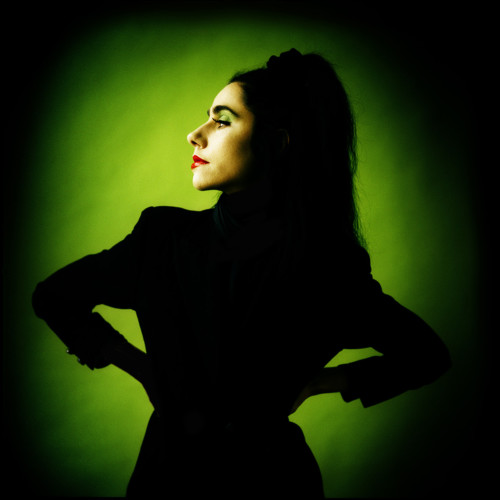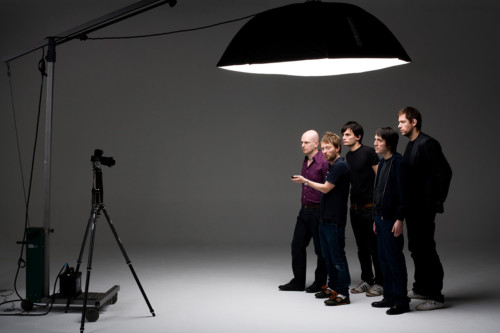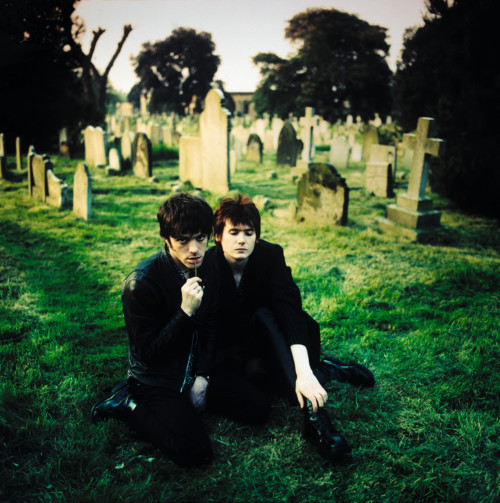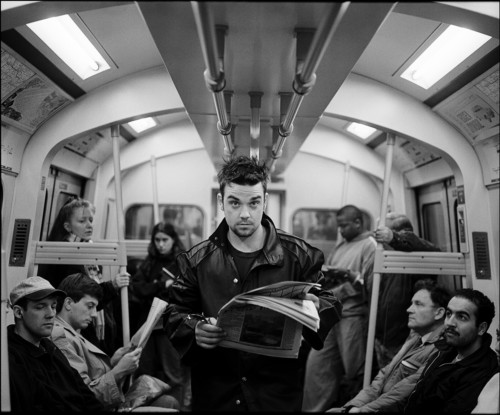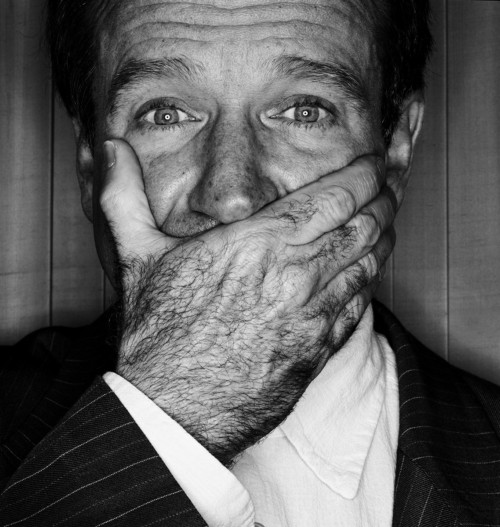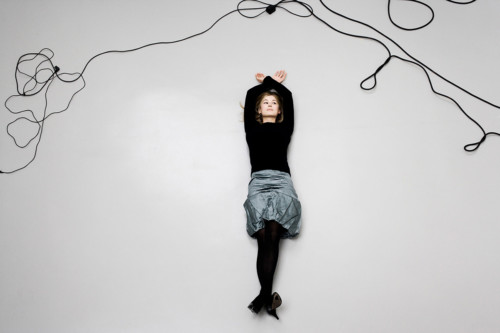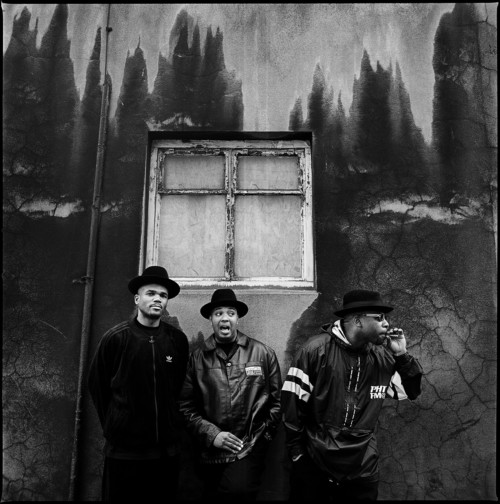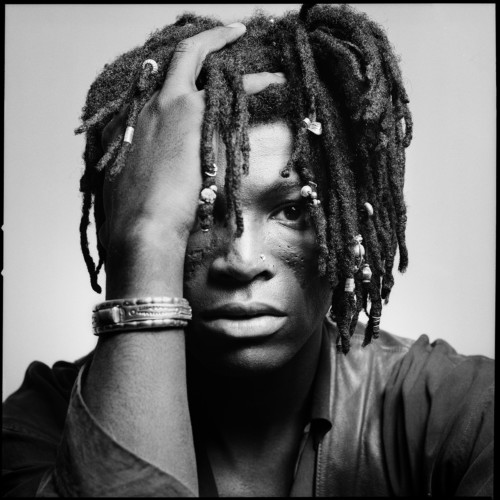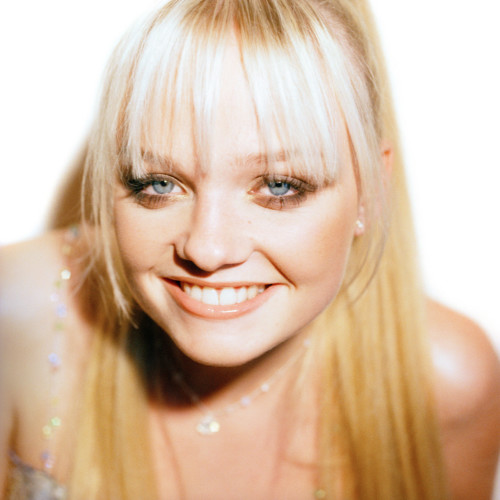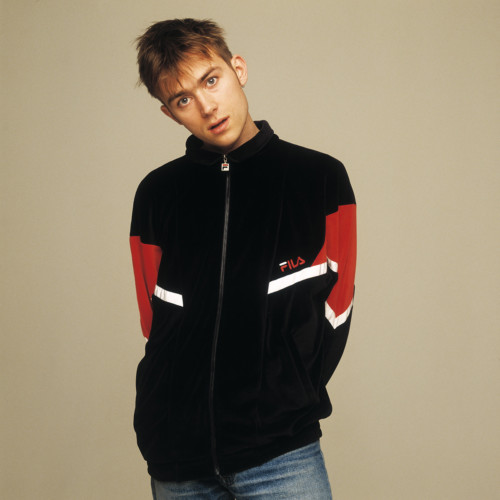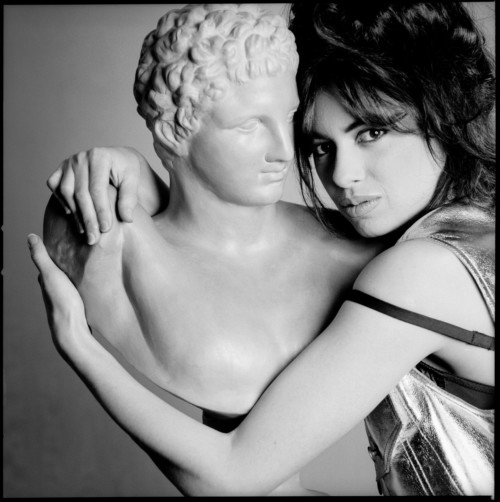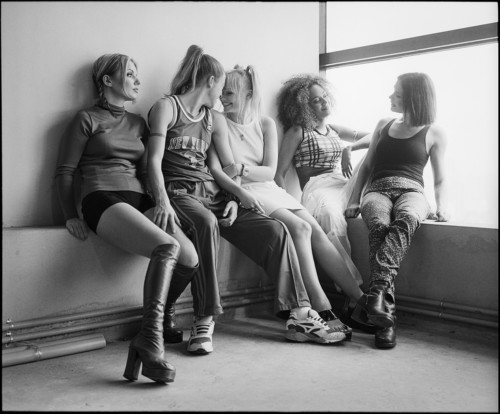-
Harry Borden: P J Harvey
£ 625 – £ 5,800PJ Harvey photographed in Harry Borden’s Bethnall Green flat, London 1996 Harry Borden recalls the shoot:" Polly Jean Harvey is an alternative rock icon. She has won the Mercury Prize twice, had eight nominations for the Brit Awards, six nominations for the Grammy Awards and was awarded an MBE in 2013 for services to music. I was commissioned to do a portrait shoot in 1996 with Polly by Option, an alternative music magazine of the time. I was a fan of her work, so it was an exciting opportunity. At the time she was popular in trendy circles, but wasn’t widely known yet. She was about as cool as you could imagine and I don’t think she’s ever lost that quality. Back then, I had a flat in London’s Bethnal Green and suggested we use it for the shoot. She turned up dressed completely in black, with green eyeshadow and red lipstick that accentuated her features. We spent a few hours taking the pictures. I chose the green background to match her eyeshadow and complement her lipstick, and set up the backdrop in the hallway. I used natural light from a window, and set it up so that most of the light fell on her face while illuminating only a small part of the backdrop. I shot this image on my Hasselblad CM with an 80mm lens. At that time, I liked a cross-processed look and this one was taken on Kodak Ektachrome Professional ISO 100 transparency film, and processed in C-41 (print film) chemicals. This produced a more contrasty image with little or no shadow detail. It was one of those occasions when cross-processing augmented the subject without being obvious. Afterwards, when a limo came to collect Polly and take her back to where she was staying in Baker Street, I asked if I could go with her. There, we found a little supermarket and I took some pictures of her as an anonymous customer. The whole shoot was great because of the combination of an incredibly photogenic subject with amazing clothes and make-up. It was one of those portrait sessions which, when you get the film back from the processing lab, you’re really delighted with. On a personal note, at the time of the shoot my wife and I were deciding on a name for our unborn child. I put the name Polly into the hat and my daughter was named after her." Available in a choice of physical size options. Please ask for framing options. Please allow 2-3 weeks between order and delivery for an unframed photograph. Framing adds 2-3 weeks. -
Harry Borden: Radiohead (2007)
£ 625 – £ 5,800Radiohead photographed at Holborn Studios, London, 2007 In 2007 I photographed Radiohead for the Observer Music Monthly. They were about to release their seventh album, In Rainbows. They were also a more cerebral outfit than most other bands, so I thought carefully about how I would photograph them. I definitely didn’t want to turn up completely unarmed to photograph a band of hip and savvy people. The Observer had hired a room at Holborn Studios in north London, but I aimed to do something different from the average studio shoot. I wanted to approach it from an alternative angle, to include some element of performance and encourage the band members to be fully engaged and collaborative. With all that in mind, I came up with the concept of allowing the band to photograph themselves. I liked the idea because they seemed empowered and in control of their destiny, so it seemed an appropriate approach, as well as being quite funny. I talked it through with the magazine’s editor, who agreed, then bought an infrared cable release so the band could fire the camera’s shutter. When they arrived for the shoot, I explained the idea to them and they were really up for it, so I went ahead with setting it up. We had the biggest studio at Holborn. The equipment included a splendid block and tackle arrangement that I’d often admired, so I decided to incorporate it in the shoot. I attached one light to it with an Octa softbox, which I love using. I only used one light because when it comes to lighting I always believe that less is more. My Canon EOS 1Ds Mark II was set up on a tripod with a 50mm lens attached. I asked the band to stand under the Octa and arranged the band members with lead singer Thom Yorke at the front. Then I gave him the infrared cable release asked him to point it at the camera. I let him take the pictures until the memory card was full. One of those images was used on the cover of Observer Music Monthly. After we had done that scenario, I borrowed my assistant’s 1DS Mark II and asked the band to stand in the same places as they were when taking their own picture. Then I switched the radio sync to my assistant’s camera and shot the whole set-up from a different angle. I got some frames of my assistant standing by the camera, but ultimately the set-up worked best when it was just the band taking pictures. My favourite shot, shown here, has Thom Yorke giving a knowing look to my camera. This picture was used inside the magazine. As well as being something different and eye-catching, it works well because I think the picture references the kind of band Radiohead is. Available in a choice of physical size options. Please ask for framing options. Please allow 2-3 weeks between order and delivery for an unframed photograph. Framing adds 2-3 weeks. -
Harry Borden: Richey Edwards and Nicky Wire
£ 625 – £ 5,800Richey Edwards and Nicky Wire of the Manic Street Preachers photographed at Brompton Cemetery, London on 30 April 1993 Harry Borden recalls the 1993 shoot at Brompton Cemetery in London. “My day with the Manic Street Preachers started with reportage black and white pictures of singer James Dean Bradfield with his cousin Sean Moore (drums) playing in a rehearsal room. The no-nonsense, engine of the band. Then later I went to Brompton Cemetery to photograph Richey and Nicky. Appearing louche, debauched and nihilistically glamorous, their contribution was a visual style that embodied the emotional alienation of the music. I arrived at the location early and explored the temples looking for good spots. Entering one of the substantial mausolea, I sensed I was not alone. There were men standing in the shadows. My heart beating, I held my heavy camera bag to my chest and walked quietly out and was relieved to see the boys waiting for me at the Fulham Road entrance. It was early evening and the unsettling encounter was forgotten, as I began to take their picture in the smoggy London light. I gave them no direction, they just sat among the gravestones. I remember thinking how easy it was to photograph Richey. He was so handsome. Less than two years later he was to disappear at the age of just twenty-seven. On the eve of a promotional trip to America, he vanished from his London hotel room, his car discovered near the Severn Bridge. Sometimes images are rendered poignant as time passes. Later I learnt the cemetery had a reputation for being a popular cruising ground for gay men so I needn’t have worried about being mugged for my cameras. Shot for Select Magazine with my Hasselblad on Kodak Vericolor colour negative film developed in E6 to produce a transparency.” Available in a choice of physical size options. Please ask for framing options. Please allow 2-3 weeks between order and delivery for an unframed photograph. Framing adds 2-3 weeks. -
Harry Borden: Robbie Williams, London (1997)
£ 625 – £ 5,800Robbie Williams photographed on the London Underground, March 1997 Harry recalls the shoot: “In early 1997, Robbie Williams was at a difficult stage in his career, and it wasn’t easy to predict what would happen next. Aged 23, he had left Take That the previous year but had yet to release his first solo album. When I was commissioned by music magazine Select to photograph him in March 1997, he seemed a little lost. The magazine had booked a studio in Clerkenwell, central London, and wanted me to shoot portraits to go with an interview by journalist Caitlin Moran. But Robbie wasn’t in the best frame of mind for the shoot. I remember clearly that I had little or no conversation with him. He wore an amazing striped suit, and I photographed him manically jumping around. It wasn’t an intimate type of shoot at all; it was just a bit crazy. His PR people were looking on and wringing their hands with anxiety. However, even in this unpredictable and dishevelled state, he was very charismatic and handsome. He had amazing eyes and was great to photograph. Aside from the studio portraits, I had other plans for the shoot. I’m a big fan of Dennis Stock’s famous photographs of actor James Dean in Times Square, and I wanted to try something similar. I liked the idea of photographing someone charismatic in an anonymous setting, so I suggested that we go outside. The people from Robbie’s management company were very concerned about him being mobbed, but I tried to persuade them that it was a good idea. I said we would just walk through Clerkenwell to Farringdon tube station, where I’d get some shots of him on the concourse, perhaps reading a newspaper. They reluctantly agreed, though I didn’t tell them my real plan – to photograph him on a London Underground train. As Robbie and I walked through the station with an entourage behind us, I told him what I was planning to do, and he agreed. So when a train pulled into the platform, he and I jumped on just as the doors were about to close. Everyone else, including his PR people and my assistant, was left on the platform. Robbie and I went one stop on the train to King’s Cross station. I had my Fujifilm GW670 (a 6x7 rangefinder camera with a 90mm lens), some Kodak Tri-X film and a tripod. I shot about 10 frames. Nobody on the train said anything to us or barely even looked up. We got out at King’s Cross and caught the train back to Farringdon. If I wanted to shoot something like that today, I’d probably have to get official permission or set it up with lots of extras. But we got away with it then because we did it so quickly. If you’re fleet-footed and completely brazen, quite often people don’t bat an eyelid. If you ask: ‘Is it okay to take the picture?’ you’re just giving people the opportunity to object. Here, we winged it and I think that energy and spontaneity is woven into the fabric of the picture. The best picture I’ve taken of him is the shot on the tube. It was selected for the 1997 John Kobal Photographic Portrait Award exhibition. It was exactly the picture I’d wanted. Even today, I can look at it and feel pleased that I managed to pull off my idea.” Available in a choice of physical size options. Please ask for framing options. Please allow 2-3 weeks between order and delivery for an unframed photograph. Framing adds 2-3 weeks. -
Harry Borden: Robin Williams
£ 625 – £ 5,800Robin Williams photographed at The Dorchester Hotel, London, 1999 Harry Borden recalls the shoot: "While I was on a trip to New York in 1999, showing my work to magazines there, I had a call from The Observer Magazine. I’d been shooting portraits for the magazine for a few years. This time I was offered the opportunity to photograph Robin Williams, who was promoting his latest film. The only catch was that I had to photograph him the next day at the Dorchester Hotel in London. Following a string of roles in films such as Dead Poets Society, Good Will Hunting and Good Morning, Vietnam, Williams was a major star and this was an exciting offer. So I cut short my trip, booked the earliest available flight from the US and arrived in London the next morning. There, I met up with my colleague, journalist William Leith. The Observer told us we would have an hour for the interview and half an hour for pictures. However, when we arrived at the Dorchester, Williams’ tough female publicist said, ‘You have half an hour for the interview and five minutes for pictures – if we have time.’ While taking in this news, we were led into Williams’ hotel room that was full of people. Williams had a big entourage, including a scary minder who was completely lacking in any warmth or sense of humour. The entire atmosphere felt rather intimidating. After the interview, I started shooting portraits. I was using a Hasselblad CM, a medium-format film camera. The lighting in the room was poor so I used a big Bowens ring flash. Although time was really limited, as I was trying to shoot the portraits, Williams talked constantly. While I was being hurried along, he was doing his shtick and trying to entertain everyone in the room. I found it really irritating. He could have said, ‘Give this guy a break and let him do his job,’ but he just shrugged his shoulders as if it was nothing to do with him and let other people be nasty on his behalf. So I had to persevere. As a passive-aggressive way of telling him to shut up, I asked him to put his hand over his mouth. It was also a way of getting his very hairy hands in the picture, which I’d first noticed years before when he acted in Mork & Mindy. I got one frame of him in that position, then he put his hand down. This was the most interesting image from the few rolls of film I managed to shoot. You can see the use of the ring flash by those distinctive ‘doughnut’ shapes reflected in his eyes. In that kind of situation, where I have very little time, I usually keep taking pictures for as long as I can. However, in this case it was starting to annoy the people in the entourage and further sour the atmosphere. When I took out my Leica and took a couple of reportage-style shots, tempers started to fray. The minder threatened to throw me out of the window if I didn’t stop and the shoot came to an abrupt end. I had rapidly shot four 12-shot rolls – two black & white and two colour. Even though my portrait of him was taken in a brief, frenzied and ultimately unhappy shoot, it’s still one of my favourites." Available in a choice of physical size options. Please ask for framing options. Please allow 2-3 weeks between order and delivery for an unframed photograph. Framing adds 2-3 weeks. -
Harry Borden: Rosamund Pike
£ 625 – £ 5,800Rosamund Pike photographed at Jasmine Studios, London, September 2006 Harry Borden recalls the shoot: "For me, improvisation is a vital part of the creative process. When I’m shooting a portrait, I enjoy looking for something that hasn’t been done before and ending up with images I hadn’t anticipated. I believe it’s better to react to what’s around you and riff off things, because then you get the unexpected. That’s what happened when I did a portrait shoot of the actress Rosamund Pike in September 2006. I had been commissioned to photograph her for the Sunday Telegraph magazine, to illustrate an interview. At the time, she was 27 and in the early stages of her successful screen career, following her debut in the Bond film Die Another Day four years earlier. The shoot took place in Jasmine Studios, which was a studio complex in Shepherd’s Bush, West London. It was a great location which had really good daylight, which I generally prefer to use, and was equipped with lots of other light sources. I arrived at the studio at 9am with my assistant, and was met by a stylist and racks of clothes to use in the shoot. While I was waiting for Pike to arrive, and afterwards when she was in hair and make-up, I anxiously paced around the outer areas of the studio. Whenever I do a studio shoot, I always walk around the immediate area to see if there are interesting places I can use. While I was wandering upstairs, I found I could get access to a mezzanine floor that looked directly down on the studio. I wondered if I could use that viewpoint in the shoot. As I had the whole morning to work with Pike, I did a variety of different shots, from tight close-ups of her face to wider shots where she was just one of many elements in the picture. I mainly used daylight, but in some I used a big Octa softbox for flattering light and a Quantum flash, which gives a much harder light. Pike is genuinely beautiful, with almond-shaped eyes. I thought she looked like a kind of British, prim Brigitte Bardot. Her experience as an actor means she’s comfortable taking direction and adopting a range of personas, poses and facial expressions. She’s very intelligent, but at the same time there’s a kind of brittle coldness about her. As the shoot progressed, I was pleased with the pictures I’d got, but still wanted to try shooting from the mezzanine floor. I took some shots of her from that viewpoint, sitting in a chair surrounded by lights. Then I decided to try a simpler image with her lying on the floor with the tangled black cables of the studio lights at the top of the frame. I would be embarrassed about asking somebody to lie on the floor unless I was sure it would make a really good picture. Making someone feel uncomfortable would be excruciating for me. It was just a question of having the strength of my convictions and asking her to do it. As it turned out, she happily agreed. She lay in different positions, but the one I liked most showed her looking to one side, with her arms above her head and both her hands and feet crossed. The pose in this picture is relaxed and psychologically submissive, but the fact that she’s crossed her hands and feet suggests she’s keeping something back. Rosamund Pike is beautiful and famous, so any professional who photographs her really has to get something good. However, although there are lots of portraits of her around, this one is special to me. It was later included in the RPS International Print Exhibition for that year. Even if it had been a more lavish shoot, I don’t think I’d have got a better picture." Available in a choice of physical size options. Please ask for framing options. Please allow 2-3 weeks between order and delivery for an unframed photograph. Framing adds 2-3 weeks. -
Harry Borden: Run DMC
£ 625 – £ 5,800Run DMC photographed near their Edgware Road hotel, London on 18 May 1998 Harry Borden recalls the shoot: “ Often I find an environment I'd like to photograph anyway—like this wall by their Edgware Road hotel. I loved the flame-like markings. After placing my subject in the location, I see what happens. This was photographed on my Hasselblad with Kodak Tri-X. Sadly, Jam Master Jay (on the right) was shot and killed in 2002." Available in a choice of physical size options. Please ask for framing options. Please allow 2-3 weeks between order and delivery for an unframed photograph. Framing adds 2-3 weeks. -
Harry Borden: Seal
£ 625 – £ 5,800Seal photographed on 23 April 1991 at his record label offices in London. Harry Borden recalls the shoot in London on 23 April 1991:“I took this photograph for the NME at his record label offices in Kensington Church Street. Such was my naivety at the time, when Warner Bros got in touch to ask about using a picture for press and publicity, I was flattered and agreed to a fee of £75. He went on to sell more than 20 million albums worldwide. I shot this on Agfa APX 100 with my Hasselblad." Available in a choice of physical size options. Please ask for framing options. Please allow 2-3 weeks between order and delivery for an unframed photograph. Framing adds 2-3 weeks. -
Harry Borden: Set of five individual Spice Girls portraits
£ 625 – £ 5,000The Spice Girls photographed in Las Vegas on 8 December 1997. A set of five individual portraits. Harry Borden recalls the shoot on 8 December 1997 in Las Vegas: “The ageing diary pages from my Filofax confirm it was my craziest week ever. Monday, I shot the Girls in Las Vegas. Tuesday, I flew to Los Angeles for artist Frank Stella. On Wednesday, I travelled to the East coast to shoot Joseph Heller in New York and finally a jaunt to Chicago for Barry Manilow. All without an assistant. These portraits were taken in my hotel room, lit with a single tungsten ‘redhead’. I realise now I was influenced by Corinne Day’s grungy portrait of Kate Moss for Vogue June 1993. By this stage the Girl Power Juggernaut was unstoppable, the previous evening I’d watched them win a Billboard Award for best album at the Hard Rock Hotel and Casino. As usual, I didn’t get long but they were fun and very professional." Available in a choice of physical size options. Please ask for framing options. Please allow 2-3 weeks between order and delivery for an unframed photograph. Framing adds 2-3 weeks. -
Harry Borden: Set of four individual Blur portraits
£ 625 – £ 5,000Blur photographed in a studio off the Kings Road Chelsea on 10 March 1994. A set of four individual portraits. Available in a choice of physical size options. Please ask for framing options. Please allow 2-3 weeks between order and delivery for an unframed photograph. Framing adds 2-3 weeks. -
Harry Borden: Susanna Hoffs
£ 625 – £ 5,800Susanna Hoffs photographed on 25 February 1991 at the Meridien Hotel on Piccadilly. Harry Borden photographed Susanna Hoffs at the Meridien Hotel, Piccadilly for NME. This photograph was used as the lead image for the article, an interview by David Quantick to promote her debut solo album, When You're a Boy. There's a great quote in the interview with David Quantick, where he explains: "...Susanna wants to talk about her NME photo session. "I enjoyed it!" she beams. "It was fun! We just got creative with it. In The Bangles' day, it was like - another photo session, four girls against the wall, let's get it over with, kind of thing." She frowns and then beams again. "But this one we had fun. It's gonna look like Helmut Newton!" Harry recalls: "Although her fame and beauty were intimidating, she was sweet and took my suggestion that she wear the hotel dressing gown we found in the wardrobe with good humour. I shot this with a Hasselblad on Agfapan 100 and Kodak Technical Pan, lit with a studio flash & brolley." Available in a choice of physical size options. Please ask for framing options. Please allow 2-3 weeks between order and delivery for an unframed photograph. Framing adds 2-3 weeks. -
Harry Borden: The Spice Girls, Bangkok (1996)
£ 625 – £ 5,800The Spice Girls, Bangkok 1996. L to R: Geri Halliwell, Melanie Chisholm, Emma Bunton, Melanie Brown, and Victoria Adams (later Victoria Beckham) Harry Borden photographed the Spice girls on four occasions and this is his favourite Spice Girls image. Harry explains: "The location for the shoot was a half-built tower block in the centre of Bangkok, chosen because their record company’s offices were on a lower floor of the building. After shooting a number of pictures on the roof, we came down to the office and they sat down, exhausted by the heat. I immediately saw that this scene would make a much better picture than the others I’d taken. So I quickly asked them to hold their positions and shot a few frames, using my Fujifilm 6x7 rangefinder, with Kodak Tri-X film." "There’s a wonderful line going through it, partly because of the way they are touching or linking arms, and the interplay between the two pairs of girls looks very natural. I also like the variation in light; Geri, on the left, is lit like a figure from a Renaissance painting, while Victoria on the other side of the frame is backlit. The fact that Geri is looking slightly distant is also appropriate; she was older and more worldly than the others and went on to leave the group in 1998. The picture only came about because I was alive to the situation and didn’t switch off - and shows that sometimes magic happens when you’re not trying too hard. A print is now in the permanent collection of The National Portrait Gallery." Available in a choice of physical size options. Please ask for framing options. Please allow 2-3 weeks between order and delivery for an unframed photograph. Framing adds 2-3 weeks.

